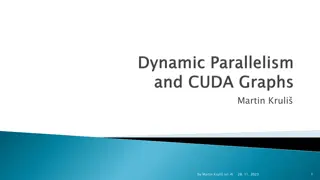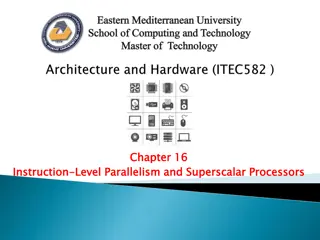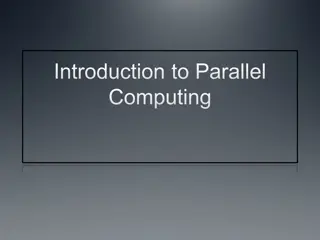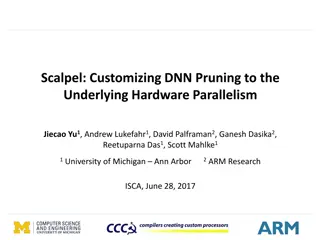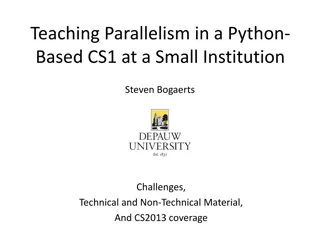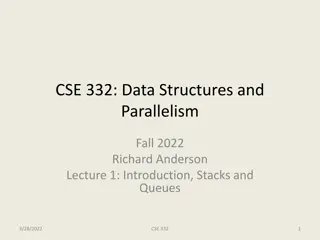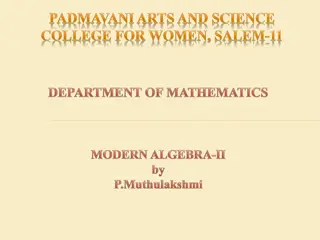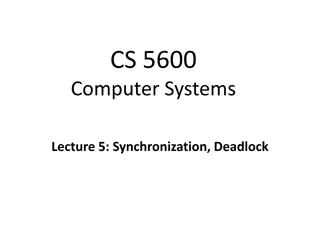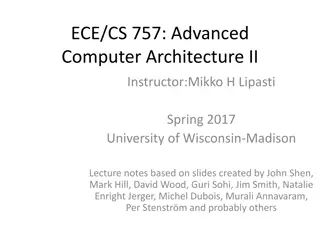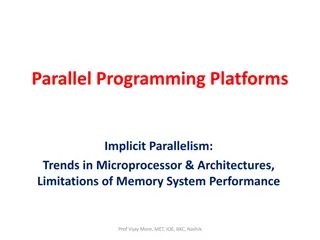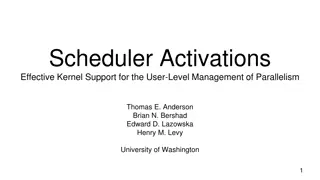Parallelism and Vector Instructions in CMPT 295
Delve into the world of parallelism and vector instructions in CMPT 295 as you explore fixed-length vector intrinsics, RISC-V concepts, computer programming fundamentals, processor execution processes, scalar and vector loops, and more. Discover the intricacies of memory, data arrays, structs, integers, floats, RISC-V assembly, procedures, stacks, executables, and caches. Enhance your knowledge of computer programs through hands-on lab assignments and insightful discussions on machine state modifications and instruction execution within a computer system.
Download Presentation

Please find below an Image/Link to download the presentation.
The content on the website is provided AS IS for your information and personal use only. It may not be sold, licensed, or shared on other websites without obtaining consent from the author.If you encounter any issues during the download, it is possible that the publisher has removed the file from their server.
You are allowed to download the files provided on this website for personal or commercial use, subject to the condition that they are used lawfully. All files are the property of their respective owners.
The content on the website is provided AS IS for your information and personal use only. It may not be sold, licensed, or shared on other websites without obtaining consent from the author.
E N D
Presentation Transcript
Parallelism and Vector Instructions CMPT 295 Parallelism and Vector Instructions CMPT 295 Week 9
Parallelism and Vector Instructions CMPT 295 Parallelism and Vector Instructions WARNING: Lab 9, Ass 5 work with fixed-length vector intrinsics. Not RISC-V - Most concepts carry over, if not programming details - RISC-V supports variable length vectors. Lab 9 and ASS 5 do not
Parallelism and Vector Instructions CMPT 295 Roadmap Memory & data Arrays & structs Integers & floats RISC V assembly Procedures & stacks Executables Memory & caches Parallelism Processor Pipeline Performance C: Java: Car c = new Car(); c.setMiles(100); c.setGals(17); float mpg = c.getMPG(); car *c = malloc(sizeof(car)); c->miles = 100; c->gals = 17; float mpg = get_mpg(c); free(c); Assembly language: OS: Machine code: 0111010000011000 100011010000010000000010 1000100111000010 110000011111101000011111 Computer system: 3
Parallelism and Vector Instructions CMPT 295 What is a computer program? for (int i = 0; i < N; i++){ output[i] = x[i] * y[i]; }
Parallelism and Vector Instructions CMPT 295 What is a computer program? Processor executes instruction referenced by the program counter (PC) (executing the instruction will modify machine state: contents of registers, memory, CPU state, etc.) # a0: &x[0], a1: &y[0], a2: &result[0], a5: N # t1 = 0: loop index i loop: # load x[i] and y[i] lw a4,0(a0) lw a3,0(a1) # multiplication mul a4,a4,a3 # store word sw a4,0(a2) # Bump pointers addi a0,a0,4 addi a1,a1,4 addi a2,a2,4 addi t1, t1, 1 bne t1,a5,loop Move to next instruction PC Then execute it And so on
Parallelism and Vector Instructions CMPT 295 Scalar Loop for (i = 0; i < N; i++){ output[i] = x[i] * y[i]; } Vector Loop (data parallelism) for (i = 0; i < N; i=i+VLEN){ output[i:i+VLEN-1] = x[i:i+VLEN-1] * y[i:i+VLEN-1]; }
Parallelism and Vector Instructions CMPT 295 7
Parallelism and Vector Instructions CMPT 295 # a0: &x[0], a1: &y[0], a2: &result[0], a5: N # t1 = 0: loop index i loop: # load x[i] and y[i] lw a4,0(a0) lw a3,0(a1) # multiplication mul a4,a4,a3 # store word sw a4,0(a2) # Bump pointers addi a0,a0,4 addi a1,a1,4 addi a2,a2,4 addi t1, t1, 1 bne t1,a5,loop for (i = 0; i < N; i++){ output[i] = x[i] * y[i]; } How many total ins? N * 9 How many useful inst? 4* N (LD,LD,MUL,ST) How many useless (maintenance) inst? 5*N
Parallelism and Vector Instructions CMPT 295 for (i = 0; i < N; i=i+VLEN){ output[i:i+VLEN-1] = x[i:i+VLEN-1] * y[i:i+VLEN-1]; } VLEN : Vector length How many total ins? N * 9 / VLEN How many useful ins ? 4*N/VLEN How many useless inst? 5*N / VLEN 9
Parallelism and Vector Instructions CMPT 295 Why Parallelism? Why Efficiency?
Parallelism and Vector Instructions CMPT 295 A parallel computer is a collection of processing elements that cooperate to solve problems quickly We care about performance We re going to use multiple processing element to get it We care about efficiency
Parallelism and Vector Instructions CMPT 295 Speedup One major motivation of using parallel processing: Speedup For a given problem: execution time (using 1 elements) execution time (using P elements) speedup =
Parallelism and Vector Instructions CMPT 295 Parallel Model: Vector Processing Vector processors have high-level operations that work on linear arrays of numbers: "vectors" VECTOR (N operations) SCALAR (1 operation) r2 r1 v2 v1 + + r3 v3 vector length add r3, r1, r2 add.vv v3, v1, v2
Parallelism and Vector Instructions CMPT 295 Parallel Model:Vector Processing Vector processors have high-level operations that work on linear arrays of numbers: "vectors" VECTOR (N operations) SCALAR (1 operation) r2 r1 v2 v1 + + r3 v3 vector length add r3, r1, r2 add.vv v3, v1, v2 out[0] = x[0]+y[0] out[1] = x[1]+y[1] . out[0:VLEN-1] = x[0:VLEN-1] + Y[0:VLEN-1] out[VLEN:2*VLEN-1] = x[VLEN:2*VLEN-1] + y[VLEN:2*VLEN-1]
Parallelism and Vector Instructions CMPT 295 Vector Registers 32 vector data registers, v0-v31, each VLEN bits long Vector length register vl Vector type register vtype Vector data registers VLEN bits per vector register, (implementation-dependent) v0 Vector register file Each register is an array of elements Size of each register determines maximum vector length Vector length register determines vector length for a particular operation Multiple parallel execution units = lanes (sometimes called pipelines or pipes ) v31 vl Vector length register vtype Vector type register 15
Parallelism and Vector Instructions CMPT 295 Baseline CPU Fetch PC mul a4,a4,a3 (scalar) ALU 0 Scalar Reg
Parallelism and Vector Instructions CMPT 295 Vector CPU: Add arithmetic units to increase compute capability Fetch Ins Fetch PC vmul v4,v4,v3 Single instruction, multiple data ALU 0 ALU 1 ALU 2 ALU 3 - Parallelism: Multiple data elements - Efficiency: Fetch single instruction ALU 4 ALU 5 ALU 6 ALU 7 Same instruction broadcast on all ALUs Each instruction updates/reads multiple elements from vector register Vector Reg
Parallelism and Vector Instructions CMPT 295 Virtual Processor Vector Model Vector operations are SIMD (single instruction multiple data) operations Each element is computed by a virtual processor (VP) Number of VPs given by vector length vector control register
Parallelism and Vector Instructions CMPT 295 Vector Architectural State Virtual Processors (#vir) VP0 VP1 VP#vlr-1 vr0 vr1 General Purpose Registers Control Registers vr31 vcr0 vcr1 #vdw bits vf0 vf1 Flag Registers (32) vcr31 32 bits vf31 1 bit
Parallelism and Vector Instructions CMPT 295 Vector Code Scalar Code for (i = 0; i < N;i=i+VLEN){ output[i:i+VLEN] = x[i:i+VLEN] + y[i:i+VLEN]; } for (i = 0; i < N; i++){ output[i] = x[i] + y[i]; } loop: # load x[i] and y[i] lw a5,0(a2) lw a6,0(a3) # addition add a5,a5,a6 # store word sw a5,0(a1) # Bump pointers addi a1,a0,4 addi a2,a1,4 addi a3,a2,4 addi a3,a2,4 sub a0,a0,1 bnez a0, loop loop: # t0=VLEN # load x[I,i+VLEN], y[] vle32.v v8, (a2) vle32.v v16, (a3) # addition vadd.vv v24,v8,v16 # store res[i:i+VLEN] vse32.v v24,(a1) # Bump pointers slli t1,t0,2 add a2, a2,t1 add a3,a3,t1 add a1,a1,t1 # Bump loop by vlen sub a0,a0,t0 bnez a0, loop
Parallelism and Vector Instructions CMPT 295 Masking and Conditional Ops - Disable unwanted vector lanes - Conditional branches where different operations for different vector elements - Handling tail/left-over elements when software array length not multiple of vector width.
Parallelism and Vector Instructions CMPT 295 Tail Processing loop: vsetvli t0, a0, e32 # Set VLEN # load x[I,i+VLEN], y[] vle32.v v8, (a2) vle32.v v16, (a3) # addition vadd.vv v24,v8,v16 # store res[i:i+VLEN] vse32.v v24,(a1) # Bump pointers slli t1,t0,2 add a2, a2,t1 add a3,a3,t1 add a1,a1,t1 # Bump loop by vlen sub a0,a0,t0 bnez a0, loop Remaining = N for (i = 0; i < N;){ int VLEN; if (N-i > MAX_VLEN) VLEN = MAX_VLEN else VLEN = N-i setvl(VLEN) res[i:i+VLEN] = x[i:i+VLEN] + y[i:i+VLEN]; }
Parallelism and Vector Instructions CMPT 295 Time What about conditional branches? 1 2 ... ... ... ALU 8 8 Assume logic below is to be executed for each element in input array A producing output into array result ALU 1 ALU 2 ... <unconditional code> float x = A[i]; if (x > 0) { float tmp = exp(x,5.f); tmp *= kMyConst1; x = tmp + kMyConst2; } else { float tmp = kMyConst1; x = 2.f * tmp; } <resume unconditional code> result[i] = x;
Parallelism and Vector Instructions CMPT 295 What about conditional branches? Time 1 2 ... ... ... ALU 8 8 Assume logic below is to be executed for each element in input array A producing output into array result ALU 1 ALU 2 ... <unconditional code> float x = A[i]; T T F T F F F F if (x > 0) { float tmp = exp(x,5.f); tmp *= kMyConst1; x = tmp + kMyConst2; } else { float tmp = kMyConst1; x = 2.f * tmp; } <resume unconditional code> result[i] = x;
Parallelism and Vector Instructions CMPT 295 Mask discard output of ALUs Time 1 2 ... ... ... ALU 8 8 Assume logic below is to be executed for each element in input array A producing output into array result ALU 1 ALU 2 ... <unconditional code> float x = A[i]; T T F T F F F F if (x > 0) { float tmp = exp(x,5.f); tmp *= kMyConst1; x = tmp + kMyConst2; } else { float tmp = kMyConst1; x = 2.f * tmp; } <resume unconditional code> Not All ALUs do useful work Worst case: 1/8 peak performance result[i] = x;
Parallelism and Vector Instructions CMPT 295 After branch continue normal execution Time 1 2 ... ... ... ALU 8 8 Assume logic below is to be executed for each element in input array A producing output into array result ALU 1 ALU 2 ... <unconditional code> float x = A[i]; T T F T F F F F if (x > 0) { float tmp = exp(x,5.f); tmp *= kMyConst1; x = tmp + kMyConst2; } else { float tmp = kMyConst1; x = 2.f * tmp; } <resume unconditional code> result[i] = x;
Parallelism and Vector Instructions CMPT 295 Terminology Instruction stream coherence ( coherent execution ) - Same instruction sequence applies to all elements operated upon simultaneously - Coherent execution is necessary for efficient use of SIMD processing resources - Coherent execution IS NOT necessary for efficient parallelization across cores, since each core has the capability to fetch/decode a different instruction stream Divergent execution - A lack of instruction stream coherence
Parallelism and Vector Instructions CMPT 295 New RISC-V V Vector Extension Standard extension to the RISC-V ISA An updated form of Cray-style vectors for modern microprocessors Appearing in commercial implementations from Alibaba, Andes, Semidynamics, SiFive, Basis of European supercomputer initiative (EPI) Following slides present short tutorial on current standard https://github.com/riscv/riscv-v-spec
Parallelism and Vector Instructions CMPT 295 RISC-V Scalar State Program counter (pc) 32x32/64-bit integer registers (x0-x31) x0 always contains a 0 Floating-point (FP), adds 32 registers (f0- f31) each can contain a single- or double- precision FP value (32-bit or 64-bit IEEE FP) FP status register (fcsr), used for FP rounding mode & exception reporting ISA string options: RV32I (XLEN=32, no FP) RV32IF (XLEN=32, FLEN=32) RV32ID (XLEN=32, FLEN=64) RV64I (XLEN=64, no FP) RV64IF (XLEN=64, FLEN=32) RV64ID (XLEN=64, FLEN=64) 30
Parallelism and Vector Instructions CMPT 295 Vector Extension Additional State Vector data registers VLEN bits per vector register, (implementation-dependent) 32 vector data registers, v0-v31, each VLEN bits long Vector length register vl Vector type register vtype Other control registers: vstart v0 For trap handling vrm/vxsat v31 Fixed-point rounding mode/saturation Also appear in separate vcsr vlenb vl Vector length register Gives vector length in bytes (read-only) vtype Vector type register 31
Parallelism and Vector Instructions CMPT 295 Vector Type Register (vtype) Ideally, info would be in instruction encoding, but no space in 32-bit instructions. Planned 64-bit encoding extension would add these as instruction bits. vsew[2:0] field encodes standard element width (SEW) in bits of elements in vector register (SEW = 8*2vsew ) vlmul[2:0] encodes vector register length multiplier (LMUL = 2vlmul = 1/8 - 8) vta specifies tail-agnostic vma specifies mask-agnostic 32
Parallelism and Vector Instructions CMPT 295 Example Vector Register Data Layouts (LMUL=1)
Parallelism and Vector Instructions CMPT 295 Setting vector configuration, vsetvli/vsetivli/vsetvl The vset{i}vl{i} configuration instructions set the vtype register, and also set the vl register, returning the vl value in a scalar register vsetvli rd, rs1, e8 # Set SEW=8, vl=min(VLEN/SEW,rs1), rd=vl vtype parameters (SEW,LMUL,TA,MA) encoded as immediate in instruction Resulting machine vector length setting Requested application vector length Instruction encoding Usually use register-immediate form, vsetvli, to set vtype parameters. Immediate-immediate form, vsetivli, used when vector length known statically The register-register version vsetvl is usually used only for context save/restore 34
Parallelism and Vector Instructions CMPT 295 Vector Length Multiplier, LMUL Gives fewer but longer vector registers Called vector register groups operate as single vectors Must use even register names only for LMUL=2 (v0,v2,..), and every fourth register for LMUL=4 (v0,v4, ), etc. Used for 1) to increase efficiency by using longer vectors 2) accommodate mixed-width operations (e.g., masks) LMUL=2 LMUL=4 35
Parallelism and Vector Instructions CMPT 295 Simple stripmined vector memcpy example Set configuration, calculate vector strip length Unit-stride vector load elements (bytes) Unit-stride vector store elements (bytes) Same binary machine code can run on machines with any VLEN! 36
Parallelism and Vector Instructions CMPT 295 Vector Unit-Stride Loads/Stores 37 for i = 0 to VLEN - 1 vd[i] = load(rs1 + i)
Parallelism and Vector Instructions CMPT 295 Vector Strided Load/Store Instructions for i = 0 to VLEN - 1 vd[i] = load(rs1 + i*rs2)
Parallelism and Vector Instructions CMPT 295 Vector Indexed Loads/Stores for i = 0 to VLEN - 1 vd[i] = load(rs1 + vs2[i]) Index data width encoded in instruction, while data size encoded in vtype.vsew field 39
Parallelism and Vector Instructions CMPT 295
Parallelism and Vector Instructions CMPT 295 LMUL=8 stripmined vector memcpy example Combine eight vector registers into group (v0,v1, ,v7) Set configuration, calculate vector strip length Unit-stride vector load bytes Unit-stride vector store bytes Binary machine code can run on machines with any VLEN! 41
Parallelism and Vector Instructions CMPT 295 Masking Nearly all operations can be optionally under a mask (or predicate) held in vector register v0 A single vm bit in instruction encoding selects whether unmasked or under control of v0 Integer and FP compare instructions provided to set masks into any vector register Can perform mask logical operations between any vector registers
Parallelism and Vector Instructions CMPT 295 Vector Integer Add Instructions 43
Parallelism and Vector Instructions CMPT 295 Integer Compare Instructions 44
Parallelism and Vector Instructions CMPT 295 Mask Logical Operations 45
Parallelism and Vector Instructions CMPT 295 Agnostic vs Undisturbed vsetvli t0, a0, e32, m1, ta, ma ma Mask agnostic mu Mask undisturbed ta Tail agnostic tu Tail undisturbed 46


